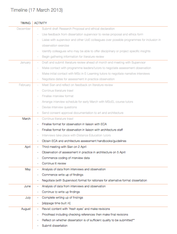Jen themes:
Sian themes:
Marshall themes:
Christine themes:
Rory themes:
Clara themes:
Hamish themes:
Where tutors have experience multimodal assessment as a student, this has influenced their attitude towards multimodality as a tutor. And this includes digital and pre-digital multimodality. This links into another idea expressed by some within interview that tutors can usefully reorient themselves by completing multimodal assessment themselves.
0 Comments
Leave a Reply. |
Categories
All
Archives
October 2013
TimelineOther stuff
|
